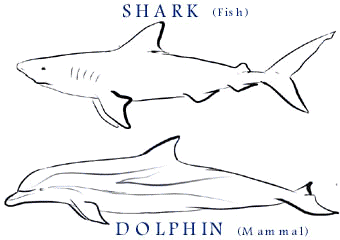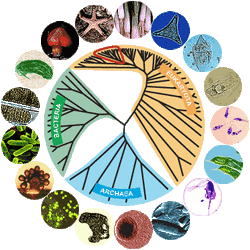Patterns of Evolution- There are three main types of evolutionary patterns. These three patterns are...
Divergent Evolution: In divergent evolution, populations that were once similar become different due to adaptations to different environmental conditions.
Convergent Evolution: In convergent evolution, species in different parts of the world become similar because of similar environments and, as a result, similar environmental pressures.
Coevolution: In coevolution, two or more species that closely interact with each other affect each other's evolution.  Convergent evolution, as seen in a shark and a dolphin.
Click image to be taken to the source.  Click image to be taken to the source. - Evolution creates a series of relationships between organisms, which can be seen in a phylogenetic tree such as the ones shown in the banner and the image above. These relationships are the domains Archaea, Bacteria, and Eukaryota.
| Processes of Evolution- Evolution changes a population's genes over time. Allelic frequencies change within a population's gene pool due to disruptions in genetic equilibrium. These disruptions in genetic equilibrium may be caused by numerous different factors, including natural selection, mutation, genetic drift, and gene flow.
Natural selection: Natural selection is typically the most significant factor in disrupting genetic equilibrium, and will be discussed further below.
Mutation: Mutations result from both environmental factors (radiation, chemicals, and the like) and mistakes in DNA replication. They include point and frameshift mutations, insertions, and deletions.
Genetic drift: Similar to mutations due to mistakes in DNA replication, genetic drift relies on chance events to cause disruptions in genetic equilibrium. Note that it is an external force that acts on random individuals within a population, often (but not always) caused by a natural disaster.
Gene flow: Gene flow relies on the movement of individuals into and out of the population. An individual's genes are added to the population's gene pool when the individual enters the population.  An example of genetic drift.
Click image to be taken to the source. - Natural selection, as described above, is typically the most significant factor in disrupting genetic equilibrium. It acts on variations in a population to determine an organism's chance of survival. There are three types: stabilizing, directional, and disruptive selection.
Stabilizing selection: favors average individuals in a population
Directional selection: favors individuals with one extreme variation of a trait
Disruptive selection: favors individuals with either one of the extremes of a trait  Click image to be taken to the source. |




